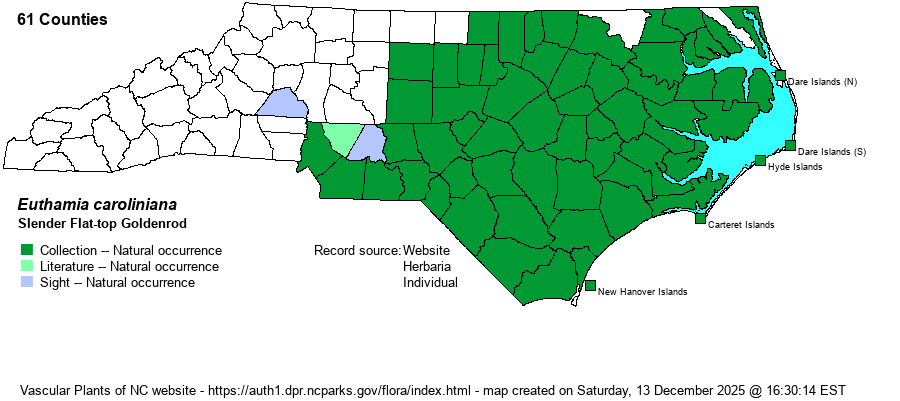| Author | (L.) Greene ex Porter & Britton | |
| Distribution | Coastal Plain, barrier islands, Sandhills, and lower Piedmont -- west to Guilford, Mecklenburg, and Catawba counties. The latter county was documented in 2021 by Sean Bloom at Buffalo Creek Preserve.
Current research (2018-21 by B.A. Sorrie) shows a range from southeastern MA to southern FL and southeastern LA; disjunct to northwestern GA. | |
| Abundance | Common to abundant in the Coastal Plain, and generally common in the eastern Piedmont. Often forms monospecific patches via horizontal rhizomes. | |
| Habitat | Xeric to dry to moist sandy soil of pine savannas, flatwoods, sandhills, Carolina bay rims, interdune swales, maritime grasslands, openings in pine-oak-hickory woodlands, barrens, old fields, roadsides, powerlines. | |
| Phenology | Flowering and fruiting late August-November. | |
| Identification | This goldenrod is readily identified by its multi-branched inflorescence of (usually) hundreds of very small heads, coupled with abundant, skinny leaves less than 2.5 mm wide and that usually show only a single vein. Heads of E. hirtipes and E. graminifolia are larger, leaves are much wider, and have 3 obvious veins. | |
| Taxonomic Comments | Synonyms include Solidago minor and S. microcephala. Some authors lump it within E. tenuifolia, but that is a more northern species that extends southward only to VA.
| |
| Other Common Name(s) | Slender Goldentop, Coastal Plain Grass-leaved Goldenrod. Slender Goldentop is often used on websites, but the use of "goldentop" instead of "goldenrod" is a seemingly new coinage for which biologists may not quite yet be ready! | |
| State Rank | S5 * | |
| Global Rank | G5 | |
| State Status | | |
| US Status | | |
| USACE-agcp | FAC link |
| USACE-emp | FAC link |

